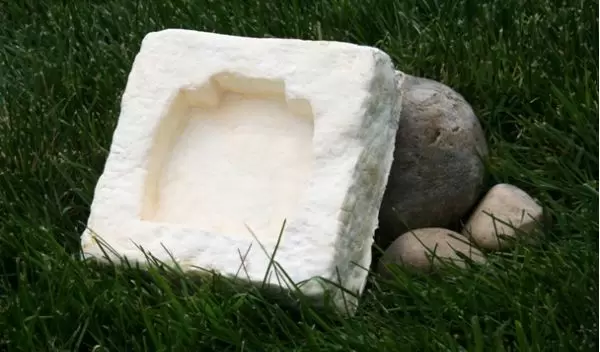
Eco-friendly Company Introduces Nature’s Packing Peanuts
In a world where plastics and synthetic foams can outlive us in landfills and have detrimental impacts on the environment, there are ways to limit such effects using something that's growing all around us.
Fungal mycelium--the root-like filaments that mushrooms spread into soil to gather nutrients as part of nature’s recycling system--provide a naturally biodegradable solution, suggest engineers Eben Bayer and Gavin McIntyre, the founders of Ecovative Design.
Five years ago, the duo created their company based on a revolutionary approach that aims to rid the world of plastics and synthetic foam by substituting them with mycelium-based products.
Bayer and McIntyre founded Ecovative after deciding to explore the possibilities fungal mycelium offered as an industrial-grade resin. Bayer initially was fascinated by mycelium on a hike, and his interest grew in the structure's ability to bind together other organic materials into a foam-like structure.
The engineers, who at the time were students at Rensselaer Polytechnic Institute in Troy, N.Y., formulated a process for using mycelium to create a material that could be transformed into desirable shapes useful for packaging and other products. Once the material served its intended use, it could easily compost, seamlessly disappearing back into the environment.
The binding process
The manufacturing process for the new foam--called MycoBond™--starts with farm-sourced plant materials that are not suitable as either food or livestock feed. The plant materials are cleaned and blended with other agricultural products, and then inoculated with mycelium. Then comes the revolutionary aspect--the product is grown, in whatever shape the consumer needs, without any energy input. No gas, no light, no human interaction.
"Mycelium adhesion operates under two different pathways," said McIntyre. "First, the mycelium travels into pores that are greater than 5 microns in diameter, which allows for exploration for nutrition. The second pathway involves the fungus creating its own holes within the substrate using complex enzymes. The mycelium network serves as a tensile skin to bond particles, or fibers, into a cohesive solid."
At the factory, the material is placed in different molds and stacked, and at the end of the process, the product is treated to prevent the growth of spores and prevent allergen concerns--a process developed with the support of National Science Foundation small business grants. Within a week, the product is ready for use by the customer.
Substrate and fungus specifications
The process is not limited by geographic availability of plant materials or feedstock. Various agricultural byproducts can be used without a drop in product performance. Feedstock is sourced regionally: New York State has abundant oat hulls, Europe can utilize buckwheat and oats, and the southern United States and Asia are able to use rice hulls as the surface upon which the mycelium grows, also called a substrate. Additionally, a product's durability is not dependent upon the substrate, but on the species and strain of fungal mycelium that is used as the resin.
"By changing the fungus, we can offer a product that will degrade in just 30 days if put into a compost pile, or last for over 30 years in an automotive application," McIntyre said.
Products
The beauty of growing materials and tailoring them to fit consumer needs is that it allows for the production of a diverse array of shapes and products. For example, the company's EcoCradle packaging serves as a replacement for standard packaging materials. The customer provides the engineering team with specs, photos and the object being shipped, and a custom EcoCradle is grown for each specific product. Once the customer has finished with the packaging, it can be placed in a garden, compost pile or yard waste and it will break down safely because only benign materials found in nature are used. [5 Hottest New Eco Tech Trends]
Since the product entered the market, customers have included DELL, Steelcase and Puma. The National Oceanic and Atmospheric Administration even enlisted Ecovative to provide a protective, eco-friendly shell for some of its buoy early warning platforms, which will be placed in oceans to help warn coastal communities of impending tsunamis. The structural polymer present in the fungal cell wall is chitin, which is also present in the shells of crustaceans. This will enable the buoys to withstand harsh ocean conditions for extended periods of time.
Bayer and McIntyre are not stopping with protective packaging. Their mushroom based technology is now providing building products for commercial and residential construction, as well. The production of standard insulation results in significant carbon dioxide emissions--Ecovative's insulation on the other hand, is grown, helps increase energy efficiency in the home, uses no toxic chemicals and is a safe alternative. The MycoBond™ insulation has achieved a class 1 fire rating and can also be bound to wood panels and used as structural insulation fit for roofing, as well as residential and commercial construction.
Cars are included in the mushroom makeovers, too. Various car parts are made of foams and plastics that are non-renewable and can release volatile organic compounds, which include a variety of harmful chemicals with adverse health effects. Ecovative is working on creating specialized mushroom materials that can be used in car parts, like bumpers, engine bays, dashboards and seats.
This Behind the Scenes article was first provided to LiveScience in partnership with the National Science Foundation.


